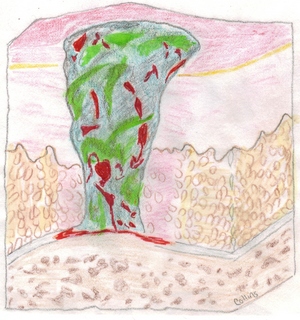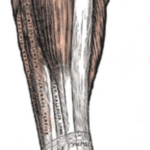Have you ever sat in one position too long and then notice a tender, reddened area? Believe it or not, this is the beginning of a pressure sore!
Pressure sores, also known as bedsores or decubitus ulcers, can develop from any prolonged position, and are a common yet serious concern for those individuals who experience prolonged periods of confinement from casts, splints, wheelchairs or bed rest.
These open sores or skin lesions are caused by external pressure impairing the local circulation – or simply put, too much pressure for too long a time. It is common with people advancing in age whose mobility or sensations are severely limited.
Even a small amount of pressure can block venous return and removal of metabolic wastes. This leads to swelling and local tissue damage, which usually occurs after a few hours. But higher pressure can result in tissue damage as quickly as a few minutes.
This swelling and tissue damage then leads to ischemia or lack of blood supply and irreversible tissue damage from lack of oxygen to the tissue cells. Retention of metabolic wastes and necrosis or death of the tissues can also occur. If left untreated, these open sores can lead to septicemia, bacteria in the blood. Once septicemia is present, the risk of death is a very real threat!
Common Causes
Both internal and external factors can lead to the formation of pressure sores. Internally, anyone experiencing a loss of pain and pressure sensations is a high risk. These sensations prompt a shift in position to relive pressure. Without them, disruptions of circulation can occur unknowingly.
Decreased fat and muscle padding over bony prominences can decrease the time it takes for a pressure sore to develop. Muscle wasting from disuse, anemia (decrease of circulating red blood cells) and infection can also contribute to these wounds.
Externally, direct pressure from infrequent position changes is a leading cause of sores. Friction and irritations, such as rubbing against sheets, wrinkled bedding or clothing and poorly adjusted supports such as splints and casts are also common causes of pressure sores. Shear forces that torque the tissue in an opposite direction can damage capillaries, thus resulting in tissue damage. Shear forces can be brought on from something as simple as slipping down in bed.
Poor nutrition can also affect the skin’s integrity. Inadequate protein intake leads to poor tissue health as does vitamin deficiencies, such as C, B12, iron and zinc.
Incontinence and perspiration can compromise tissues through prolonged exposure to moisture. Moisture can lead to maceration or softening of the skin. Prolonged exposure to the enzymes in urine or fecal matter causes skin breakdown.
Some medications can also contribute to breakages of skin integrity. Tranquillizers, sedatives and opiates decrease sensory perception and mobility. Steroids can disrupt the normal healing process due to their anti-inflammatory properties. This can result in decreasing the general health of tissues.
Areas of Concern
Sores can occur anywhere there is a prolonged pressure. Most commonly, these types of wounds are found over bony prominences such as the sacrum or triangular bone that makes up your pelvis; the greater trochanter or the sides of your hips; the spine; the elbows, ankles and heels. Other common sights include the ears, shoulders, knees and the soles of the feet.
Stages
Like other types of wounds, these ulcers are classified according to the amount of tissue damage.
Stage 1 – This is the earliest stage of pressure sores. It consists of skin redness that disappears on pressure with palpable warmth. There is no breakage of the skin and the underlying tissues are still soft. If the discoloration continues after 30 minutes, the risk of skin breakdown greatly increases.
Stage 2 – Redness, swelling and hardening of the tissues is evident in this stage. The area becomes more discolored and may be moist and painful. A blister, abrasion or shallow ulcer may also be present.
Stage 3 – This stage involves a definite break in the skin with tissue death and exposure of the underlying layers beneath the skin. There is typically exudate or an accumulation of fluids in the area. This exudate may dry and crust over the cavity in the skin. The crust is called eschar. Eschar is thick, leathery dead tissue.
Stage 4 – There is full tissue damage at this stage with necrosis or death occurring to the underlying muscle and bone. The cavity, which may be very deep or tunneling, may be fully covered with eschar, which can lead to sepsis or poisoning of the blood.
Stage 5 – Continued death of the underlying muscles and bones is characteristic of this stage.
Stage 6 – This is where bone destruction begins with periostitis or inflammation of the covering of bone, and osteitis, inflammation of the bone itself. Progression continues with the presence of osteomyelitis or inflammation of the bone, especially in bone marrow. Bone fractures can occur at this stage.
Risks increase for septic arthritis or joint inflammation as a result of poisonous products in the bloodstream, and septicemia. Septicemia or blood poisoning can cause an overwhelming infection throughout the body and increase the risk of death.
What To Do
The best form of treatment for pressure sores is prevention! The best way to prevent these wounds is pressure relief through position changes at least every two hours – more with decreased pressure and pain sensation. The use of water beds, air beds, sponge rubber “egg crate” cushions, sheepskin protective padding and silicone gel pads or mattresses decrease pressure, but does not negate the need for positional changes. Proper positioning utilizing pillows or padding over bony prominences, such as between knees, can decrease risks.
Skin inspection is suggested with positional changes. Visual inspection as well as palpation is necessary, as pressure wounds can start before the skin integrity is actually broken down. Maintaining a clean, dry environment prevents softening of the skin, which can lead to breakdown. Minimizing wrinkles in clothing and bed sheets will also aid in even distribution of weight.
Promoting an increase of circulation is also beneficial. Physical therapy can provide passive and active exercises to increase circulation. Hydrotherapy may also be a valuable addendum to daily routine. Certain massage techniques can also increase circulation, but care must be taken to avoid a dragging of fragile skin, which will increase the odds of a sore.
Help! I Have A Pressure Sore!
One of the most difficult problems in treating these ulcers is the extent of damage remaining unseen. Tissue damage may begin underneath intact skin or only a small open spot may be visible, yet the damage may include an extensive amount of tissue underneath, like a tunnel.
Stage 1 and 2 pressure sores benefit from careful execution of the preventative measures listed above to prevent tissue death. Spontaneous healing can occur up to stage 3. But beyond stage 3 requires extensive medical treatment.
Stage 4 sores require debridement or removal of dead tissue by a qualified medical professional with forceps and scissors followed by hydrophilic gels and dressings to speed healing. Hydrotherapy may assist in the debridement process. Occasionally, the use of electrical stimulation may be used to speed healing. But care of a wound this severe should only be by a trained medical professional!
Surgical debridement may be necessary for more advanced ulcers with fat and muscle involvement. Surgical removal of affected bone may also be necessary. For large areas, skin grafting may be utilized to minimize infections and speed healing.
Pressure sores, though seemingly trivial, can cause serious problems – even death, and should never be treated lightly. But with a little extra vigilance, these potentially life-threatening ulcers can be prevented!


